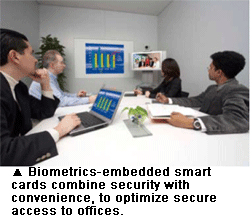Biometric readers are now being placed on wireless access control cards, which clearly enhance the convenience of validating one's identity; but the real opportunity is in universal biometric access.
Biometric readers are now being placed on wireless access control cards, which clearly enhance the convenience of validating one's identity; but the real opportunity is in universal biometric access.
Imagine the convenience of having a biometric reader on a building access control card. You would simply hold it like your car door fob, gain validation as you move toward the door, and then walk right in. Speeding one's access into the office begins to remove some of the burden security systems have systematically added to our work lives over time.
But it's better than that: By combining biometrics with wireless communications as an overlay to existing access control systems, entry and admission become more convenient for the user. This is the ultimate in security: universal hands-free access, validated by unique human characteristics.
The flexibility of having a biometric reader on one's access control card means one could gain access while walking up to and then through a doorway. This requires the reader and wireless communications, and the power to drive both onboard a credential. It also requires that the identity documentation be in an acceptable form factor (i.e. small size) and at an acceptable cost.
How It Works
The placement of a biometric reader on a card is straight forward. The user enrolls their finger print(s) and when ready to access a facility, places their thumb on the card to trigger an authenticated transmission. Similar wireless communications are prevalent today, but what we are talking about are long-range transmissions from small cards without the consumption of too much power. Recent inventions in micro-wireless communications now makes it possible to transmit robust signals over a significant distance, say 100 feet using small watch-type coin cell batteries embedded along with wireless electronics into access cards.
Hands-free access control systems are often used in large enterprises where  the number of shift worker employees is sizeable. In these instances mass personnel access accounting takes place which provides, for example, data contractor time and attendance and billing. The technology provides the location of employees which can be mapped to training certification for safety awareness. In addition, it supports emergency evacuation accounting, mandated by the U.S. Government Occupational Safety and Health Administration (OSHA).
the number of shift worker employees is sizeable. In these instances mass personnel access accounting takes place which provides, for example, data contractor time and attendance and billing. The technology provides the location of employees which can be mapped to training certification for safety awareness. In addition, it supports emergency evacuation accounting, mandated by the U.S. Government Occupational Safety and Health Administration (OSHA).
Enhanced Security, Productivity and Enterprise Efficiencies
Long-range wireless credentials today reduce direct costs and liabilities while increasing security, productivity and enterprise efficiencies. Putting them together with distributed or de-centralized on-card biometric validation provides an even more powerful advanced workforce management tool. Many of today's systems have the ability to communicate with multiple panels enterprise-wide. As for this procedure, access control systems manage unique numbers for authorized entry.
With the biometric data on board, the card matching occurs on the card. Then, only the access control ID number is transmitted. This keeps the security of the encrypted biometric file intact, while only the existing access control number is transmitted. It too is compared by the access control system against an authorized list prior to entry being authorized. The card is secure. The system is secure. Lost cards and invalid numbers are handled as before.
The Road to Adoption
The slow adoption rate of biometric access systems has been due to the closed systems architecture of the readers at the doorways and the cost of deploying them enterprise-wide. By moving biometric validation out to the card, the credentialing process becomes a discrete and individualized operation. Once accomplished, the card simply behaves as a normal access control card, transmitting its code and seeking authorized access.
One now has the ability to deploy biometrics selectively, utilizing and enhancing all the access control system infrastructures existing today worldwide. A low-cost biometric credential will pave the way toward their rapid introduction and proliferation. With the option of biometrics on the access card, there is more flexibility on where and when to implement the technology. The business benefits of hands-free, biometrically- validated access relates directly to time on the job and to facility security. Time on the job is often referred to as "wrench time" and hands-free credential systems have been proven to increase that wrench time by more than 10 percent. Biometric validation simply makes the access control process more secure.
The time delay in biometrics often relates to the time it takes to match the template to the person's file in the enterprise database. With the biometric template on the card versus at doorways, the 1:1 matching of the template data to the file occurs while the person is walking up to the doorway, thus reducing the matching time and speeding up validation and access.
With more rapid and secure access it is also easier to deploy internal security. Using standard, low-cost legacy access control panels, they can be set up at the entrances to internal areas vulnerable to loss. Establishing internal security with on-board biometrics increases security without hampering high speed throughput.
Having the biometrics de-centralized on wireless access control credentials means existing legacy access control systems can implement biometrics enterprise-wide. Biometrics can be introduced at a lower cost, in a secure fashion phased in at an individual site and migrated to multiple sites over time. Throughput is improved, thereby increasing enterprise productivity. Security is improved, resulting in reduced loss. Overall, the cost of implementation is reduced with flexibility to further apply it where needed over time. The ultimate in access security is achievable, universal hands-free access, biometrically validated.